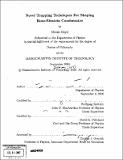| dc.contributor.advisor | Wolfgang Ketterle and David E. Pritchard. | en_US |
| dc.contributor.author | Boyd, Micah (Micah Scott) | en_US |
| dc.contributor.other | Massachusetts Institute of Technology. Dept. of Physics. | en_US |
| dc.date.accessioned | 2007-10-22T17:32:14Z | |
| dc.date.available | 2007-10-22T17:32:14Z | |
| dc.date.copyright | 2006 | en_US |
| dc.date.issued | 2007 | en_US |
| dc.identifier.uri | http://hdl.handle.net/1721.1/39296 | |
| dc.description | Thesis (Ph. D.)--Massachusetts Institute of Technology, Dept. of Physics, February 2007. | en_US |
| dc.description | Includes bibliographical references (p. 125-133). | en_US |
| dc.description.abstract | A combination of radio frequency radiation and magnetic field gradients was used to trap atoms in dressed states. In a magnetic field with a quadrupole minimum. RF fields resonant with the (I F. m)) 11. -1) -- 1, 0) transition trapped the atoms on the surface of a sphere, and gravity caused the atoms to pool at the bottom of the sphere. BECs were transferred into this dressed Zeeman trap with 100% efficiency, with lifetimes of up to 30 s, and trapping frequencies of up to 250 Hz were measured. A hard disk platter with a specially written magnetic pattern was used to generate magnetic fields to confine atoms tightly. Detrimental interactions with the surface were avoided by using an extremely thin film with a large magnetic remnant. BECs of up to 5 x 10" atoms were produced in cigar shaped traps -40 pin above the surface, and trap frequencies up to 5 kHz were measured. After evaporation, condensed clouds moved(] closer to the surface to probe imperfections in the magnetic potential, revealing defects at distances closer than 35 prn. Finally, BECs were dropped from a height of 350 pm in an attempt to achieve specular reflection. but a large amount of dispersion was observed. | en_US |
| dc.description.abstract | (cont.) Finally, BECs were loaded into a three-dimensional optical lattice, and a quantum phase transition from a superfluid to a Mott insulator was observed. Using microwave spectroscopy. the density dependent "clock shift" was was found to depend on the occupation number of the wells. The singly occupied lattice sites were then investigated as an atomic clock system with no density shift. Linewidths as small as 1 Hz FWHMI out of 6.8 GHz are comparable to current atomic frequency standards. | en_US |
| dc.description.statementofresponsibility | by Micah Boyd. | en_US |
| dc.format.extent | 133 p. | en_US |
| dc.language.iso | eng | en_US |
| dc.publisher | Massachusetts Institute of Technology | en_US |
| dc.rights | M.I.T. theses are protected by copyright. They may be viewed from this source for any purpose, but reproduction or distribution in any format is prohibited without written permission. See provided URL for inquiries about permission. | en_US |
| dc.rights.uri | http://dspace.mit.edu/handle/1721.1/7582 | |
| dc.subject | Physics. | en_US |
| dc.title | Novel trapping techniques for shaping Bose-Einstein condensates | en_US |
| dc.type | Thesis | en_US |
| dc.description.degree | Ph.D. | en_US |
| dc.contributor.department | Massachusetts Institute of Technology. Department of Physics | |
| dc.identifier.oclc | 173176014 | en_US |
